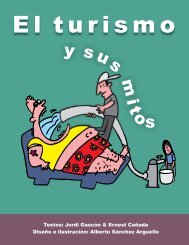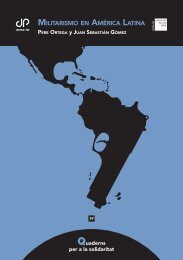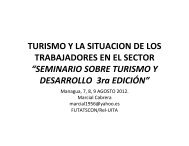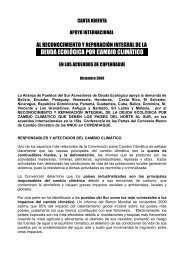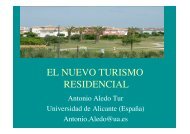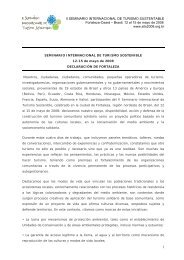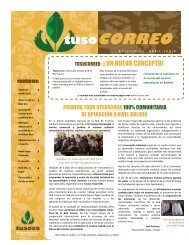<strong>Beyond</strong> <strong>Greening</strong>: Reflections on <strong>Tourism</strong> in the Rio-Process | PositioningpaperEco-<strong>Tourism</strong> – Great Potential for Economic Development in Extractive ReservesPrainha do Canto Verde pioneered community tourism in Brazil when the residents started toexplore the activity in an organized fashion in 1998. Women, men and adolescents providetourism services in guesthouses, restaurants, or by offering transfers, excursions, and eco-trailswith local guides. Community and school infrastructure is used to organise meetings withgroups from schools and universities, and exchange visits from protected areas from aroundthe country.Service groups provide coffee breaks and look after the meeting room facilities where allnecessary equipment – television, video and data show – is available and community groupstalk about the village history. Other residents use their talents for arts and handicrafts whichare sold at the local fair trade shop together with natural products from the village and othercommunities from the state of Ceará which joined in the community tourism and fair tradenetworks.The TUCUM tourism network already has 12 members along the 574 km coastline of the stateof Ceará. Six fair trade outlets of the Bodega Network are consolidating their marketing effortand planning to sell online soon. Other people benefitting from the demand of tourists forhealthy food are local farmers. The great advantage of community tourism is that nobodydepends on the tourism revenue for survival, so the people can live with the low season.Income from tourism, arts and handicrafts, family agriculture and computer andcommunication services complement income from the principal activities like fishing,hunting, foresting, and agriculture depending on the eco-system where the community islocated.Since the community of Prainha do Canto Verde has joined Extractive Reserves in 2009, it hasdrawn attention to the potential of eco-tourism. Prainha do Canto Verde receives over 1,200tourists per year with 3,105 overnights distributed in five guesthouses. Several groups fromother protected areas from all over Brazil have already visited Prainha and the case study hasbeen presented in workshops joining hundreds of people from RESEX and other protectedareas. We hope that Instituto Chico Mendes will join forces with the Ministry of <strong>Tourism</strong> todevelop this promising segment of tourism to promote economic development, natureconservation and meaningful, sustainable poverty reduction.84
<strong>Beyond</strong> <strong>Greening</strong>: Reflections on <strong>Tourism</strong> in the Rio-Process | PositioningpaperInternational Financial Institutions Gaining Ground: <strong>Tourism</strong>Infrastructure Development in IndiaBy EquationsSince the later part of the 1990s, International Finance Institutions (IFIs) have been gainingground in India. They have been finding it easy to operate in an environment where an ad hocattitude ruled the roost, and where a deregulated and fully liberalised tourism economy haderased spaces for local communities to raise their voices. In 1997, four member countries 53 ofthe South Asian Association for Regional Cooperation (SAARC) agreed to the formation of asub group termed the South Asian Growth Quadrangle. Cooperation was focused onsustainable utilization of natural resources (water and energy), trade and investment,transportation and tourism. The Asian Development Bank (ADB) vigorously pushedsubregional economic cooperation in South Asia modelled after what it had done in GreaterMekong Subregion. Despite serious criticism of projects that are planned away from thepublic gaze and without community participation, the push for IFI-advised tourismdevelopment continues.Implementation Problems in the 1990sThe 1990s saw a sudden spurt in IFI presence in tourism. But there were problems associatedwith tourism development projects funded by the IFIs, as highlighted by the Comptroller andAuditor General of India (CAG) 54 . The CAG Audit report on Union Government (Civil) forthe year ending March 31, 1999 reported that Ministry of <strong>Tourism</strong> released funds for 158tourism infrastructure projects during the period 1992-1997 under the scheme titled"Development of <strong>Tourism</strong> Infrastructure". The scheme wasaimed at ensuring comfortable and moderateaccommodation to tourists at reasonable rates by way ofconstructing hospitality facilities such as tourist bungalows,complexes, lodges, reception centres, way-side amenities,etc. Central assistance was provided to state governments ona cost-sharing basis. The state governments were generallyexpected to meet the cost of land identified for the projectwith other ancillary facilities such as electricity, water supplyand approach road; while the central ministry was expectedto meet the cost of construction, including internalelectrification, water supply and sanitary fittings etc.119 out of these 158 projects were not completed as of June1999. Test checks of accounts had shown that in respect of67 projects, delay in implementation of 14 months to 65months was attributed to non-availability of land, change in53The South Asian Growth Quadrangle consists of Bangladesh, Bhutan, Nepal and the North eastern states of India (Arunachal Pradesh,Assam, Manipur, Meghalaya, Mizoram, Nagaland, Tripura and Sikkim)54The Comptroller and Auditor General (CAG) of India audits all receipts and expenditure of the Government of India and the stategovernments, including those of bodies and authorities substantially financed by the government.85



